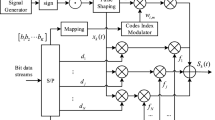Abstract
In order to overcome the shortcomings of low transmission rate in multi-user orthogonal multi-level DCSK (MOM-DCSK) communication system, a novel DCSK-based communication system is proposed. The new system is based on the time-reversal technology, M-ary and quadrature modulation. In this paper, K bits data are mapped to multi-transmission coefficients, distinguished by different Walsh codes and then transmitted on N in-phase and orthogonal carriers. The introduction of time-reversal architecture brings additional benefits such as doubling of band utilization and transmission rates. At the receiver, the received signals are input into moving average filters, in which the added noise variance is greatly reduced, thus reducing the system bit error rate (BER). Theoretical BER under additive white Gaussian noise (AWGN) and multipath Rayleigh fading channels are derived and simulated, which are consistent with the numerical simulation results and prove the correctness of the formula. Compared with various systems, the results show that the proposed system has higher transmission rate and lower BER, which proves the rationality and superiority of the system as well as the feasibility of practical engineering applications.













Similar content being viewed by others
References
Mesloub A, Boukhelifa A, Merad O, Saddoudi S, Younsi A, Djeddou M (2017) Chip averaging chaotic on–off keying: a new non-coherent modulation for ultra wide band direct chaotic communication. IEEE Commun Lett 21(10):2166–2169
Lau F, Tse C (2003) Chaos-based digital communication systems: operating principles, analysis methods. Performance evaluation
Liu Z, Zhang L, Wu Z, Bian J (2019) A secure and robust frequency and time diversity aided ofdm–dcsk modulation system not requiring channel state information. IEEE Trans Commun 68(3):1684–1697
Kurian AP, Puthusserypady S, Htut SM (2005) Performance enhancement of ds/cdma system using chaotic complex spreading sequence. IEEE Trans Wireless Commun 4(3):984–989
Fang Y, Xu J, Wang L, Chen G (2012) Performance of mimo relay dcsk-cd systems over nakagami fading channels. IEEE Trans Circuits and Syst I Regular Papers 60(3):757–767
Fang Y, Wang L, Chen G (2013) Performance of a multiple-access dcsk-cc system over nakagami-m fading channels. In: 2013 IEEE international symposium on circuits and systems (ISCAS). IEEE, pp 277–280
Xu W, Wang L, Chen G (2010) Performance of dcsk cooperative communication systems over multipath fading channels. IEEE Trans Circuits Syst I Regular Papers 58(1):196–204
Chong C-C, Yong SK (2008) Uwb direct chaotic communication technology for low-rate wpan applications. IEEE Trans Veh Technol 57(3):1527–1536
Kaddoum G, Richardson F-D, Gagnon F (2013) Design and analysis of a multi-carrier differential chaos shift keying communication system. IEEE Trans Commun 61(8):3281–3291
Mazzini G, Setti G, Rovatti R (1997) Chaotic complex spreading sequences for asynchronous ds-cdma. i. system modeling and results. IEEE Trans Circuits Syst I Fund Theory Appl 44(10):937–947
Cai X, Xu W, Wang L, Kolumbán G (2019) Multicarrier m-ary orthogonal chaotic vector shift keying with index modulation for high data rate transmission. IEEE Trans Commun 68(2):974– 986
Taleb F, Bendimerad FT, Roviras D (2016) Very high efficiency differential chaos shift keying system. IET Commun 10(17):2300–2307
Quyen NX (2017) On the study of a quadrature dcsk modulation scheme for cognitive radio. Int J Bifurcation Chaos 27(09):1750135
Lin Z, Weikai X, Ling W, Guofa C, Wei H (2016) Code reuse differential chaos keying performance analysis and synchronization algorithm. J Chongqing Univ Posts Telecommun Natural Sci Edn 28 (3):330–336
Kaddoum G, Soujeri E, Arcila C, Eshteiwi K (2015) I-dcsk: an improved noncoherent communication system architecture. IEEE Trans Circuits Syst II Express Briefs 62(9):901–905
Zhang G, Kerong X, Lifang H (2021) Orthogonal multi-user short reference high-speed differential chaos keyed communication system. J Electron Inf Technol 43(11):3131–3140
Lin Z, Bingjun C, Zhiqiang W (2021) Reliable multi carrier differential chaos shift keying receiver based on low rank approximation of matrices estimation. J Electron Inf Technol 43(1):37–44
Ma H, Cai G, Fang Y, Chen P, Chen G (2019) Design of a superposition coding ppm-dcsk system for downlink multi-user transmission. IEEE Trans Veh Technol 69(2):1666–1678
Lu Y, Miao M, Wang L, Xu W (2020) A multilevel code-shifted differential chaos shift keying system with reference diversity. IEEE Trans Circuits Syst II Express Briefs 67(11):2462–2466
Gang Z, Jinhui L, Peng Z (2020) Multi-user orthogonal multi-level differential chaotic keyed communication system. Syst Eng Electr 43(1):244–250
Cai G, Wang L, Chen G (2016) Capacity of the non-coherent dcsk system over rayleigh fading channel. IET Commun 10(18):2663–2669
Dawa M, Kaddoum G, Sattar Z (2017) A generalized lower bound on the bit error rate of dcsk systems over multi-path rayleigh fading channels. IEEE Trans Circuits Syst II Express Briefs 65(3):321–325
Yang H, Tang WK, Chen G, Jiang G-P (2016) System design and performance analysis of orthogonal multi-level differential chaos shift keying modulation scheme. IEEE Trans Circuits Syst I Regular Papers 63(1):146–156
Acknowledgements
The valuable comments and suggestions from anonymous reviewers are sincerely appreciated which helps to improve our study in the future.
Funding
This work was supported by the National Natural Science Foundation of China (No. 61771085), and the Research Project of Chongqing Educational Commission (KJ1600407, KJQN201900601).
Author information
Authors and Affiliations
Corresponding author
Ethics declarations
Conflict of interest
The authors declare no competing interests.
Additional information
Publisher’s note
Springer Nature remains neutral with regard to jurisdictional claims in published maps and institutional affiliations.
Gang Zhang and Lifang He contributed equally to this work.
Rights and permissions
Springer Nature or its licensor (e.g. a society or other partner) holds exclusive rights to this article under a publishing agreement with the author(s) or other rightsholder(s); author self-archiving of the accepted manuscript version of this article is solely governed by the terms of such publishing agreement and applicable law.
About this article
Cite this article
Zhang, G., He, P. & He, L. Multi-carrier multi-level DCSK communication system based on time-reversal. Ann. Telecommun. 78, 235–247 (2023). https://doi.org/10.1007/s12243-022-00942-7
Received:
Accepted:
Published:
Issue Date:
DOI: https://doi.org/10.1007/s12243-022-00942-7




